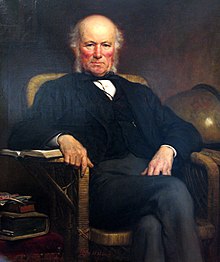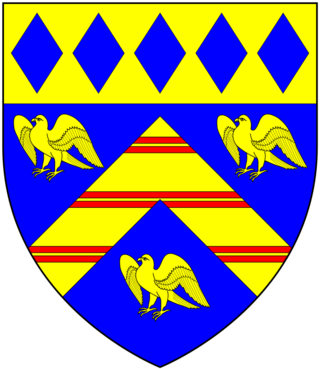
The Devonshire Association (DA) is a learned society founded in 1862 by William Pengelly and modelled on the British Association, but concentrating on research subjects linked to Devon in the fields of science, literature and the arts. [1]

The Devonshire Association (DA) is a learned society founded in 1862 by William Pengelly and modelled on the British Association, but concentrating on research subjects linked to Devon in the fields of science, literature and the arts. [1]
The first meeting was held in Exeter, England in 1862 with a membership of 69 and, except for 1942, meetings have been held annually in different locations around the county every year since. [2] James Hine, a Plymouth architect and the association's president in 1897, was the last remaining founding member of the association at the time of his death in 1914. [3] The only time the association has met outside of Devon was when it held its annual meeting in Launceston as Hine was too ill to travel. [3] Although similar in format to older groups such as the Plymouth Institution (inaugurated in 1812) and the Devon and Exeter Institution (1813), The Devonshire Association's aims were broader and more ambitious.
By 1877, there were around 500 members and this number remained fairly constant until just before the Second World War. In 1932 the first of a number of local branches was established in Plymouth, and subject-based sections were formed, specialising in botany, buildings, entomology, geology, history, literature, folklore and the dialect of Devon. [4] By 1952 membership had risen to 1,100 and to over 1,800 by the centenary in 1963. [2] In 2009 membership stood at 1,306.
The DA is a registered charity. [5] Annually, it publishes its Report and Transactions which includes reports from the sections and branches, and peer reviewed research papers. [6]
The association's three-day annual conference takes place in June, at a different Devon venue each year. At this event local visits are organised, along with a formal dinner and an AGM, at which an honorary president takes office, invited from those "of standing and importance" in the county. [2] Since 2006 the association has also held an annual President's Symposium on a topic of his or her choosing; the one in 2007, for instance concerned farming in Devon. [7]
A number of events take place throughout the year, including presentations, visits to notable places in the county, and training courses on various aspects of the association's work. The DA also makes grants to support Devon-related research projects.
The President for 2010–11 was Roger Thorne, JP, CEng, MICE, FSA who was succeeded by Professor Nicholas Orme, MA, DPhil, DLitt, FSA, FRHistS in 2011. [8] The association's 150th anniversary in 2012 was marked by a major conference in Torquay, the home town of its founder, William Pengelly. [6]
The year shown is the one in which the Presidential address was given. [8] [9]

Devon is a ceremonial county in South West England. It is bordered by the Bristol Channel to the north, Somerset and Dorset to the east, the English Channel to the south, and Cornwall to the west. The city of Plymouth is the largest settlement, and the city of Exeter is the county town.

Sabine Baring-Gould of Lew Trenchard in Devon, England, was an Anglican priest, hagiographer, antiquarian, novelist, folk song collector and eclectic scholar. His bibliography consists of more than 1,240 publications, though this list continues to grow.

Baron Roborough, of Maristow in the County of Devon, is a title in the Peerage of the United Kingdom. It was created on 24 January 1938 for Sir Henry Lopes, 4th Baronet. He had earlier represented Grantham, Lincolnshire, in Parliament as a Conservative. The Baronetcy, of Maristow House in the County of Devon, had been created in the Baronetage of the United Kingdom on 1 November 1805 for Manasseh Masseh Lopes, a member of a wealthy family of Portuguese Jewish origin, with special remainder to his nephew Ralph Franco, son of his sister Maria. Manasseh Masseh Lopes converted to Christianity in 1802, and later represented Evesham, in Worcestershire, Barnstaple in Devon, and Westbury in Somerset, in Parliament. However, in 1819 he was twice convicted of bribing the voters in both Barnstaple and Grampound in order to be elected to Parliament, and was sentenced to imprisonment and heavy fines. He was also unseated by the House of Commons, but after his release from prison he nonetheless got elected for Westbury, a pocket borough which he controlled to a great extent.

William Pengelly, FRS FGS was a British geologist and amateur archaeologist who was one of the first to contribute proof that the Biblical chronology of the earth calculated by Archbishop James Ussher was incorrect.

Leonard Knight Elmhirst was a British philanthropist and agronomist who worked extensively in India. He co-founded with his wife, Dorothy, the Dartington Hall project in progressive education and rural reconstruction.

Hele's School, formerly Plympton Grammar School, is a mixed Academy school and Sixth Form in the Plympton district of Plymouth, England, 6 miles (9.7 km) east of Plymouth city centre. Until 31 March 2011, Hele’s was a community school funded by the Local Education Authority (LEA), which is Plymouth City Council. From 1 April 2011, Hele's became an Academy, which among other things gives the school financial and educational independence. The school has a voluntary Combined Cadet Force with Navy, Army and RAF sections. Cadets in the CCF are given the option to take part in the annual Ten Tors Challenge on Dartmoor.
Courtenay Arthur Ralegh Radford was an English archaeologist and historian who pioneered the exploration of the Dark Ages of Britain and popularised his findings in many official guides and surveys for the Office of Works. His scholarly work appeared in articles in the major British journals, such as Medieval Archaeology or the Proceedings of the British Academy and in the various Transactions of archaeological societies.
Rev. John Prince (1643–1723), vicar of Totnes and Berry Pomeroy in Devon, England, was a biographer. He is best known for his Worthies of Devon, a series of biographies of Devon-born notables covering the period before the Norman Conquest to his own era. He became the subject of a sexual scandal, the court records of which were made into a book in 2001 and a play in 2005.

Tristram Risdon was an English antiquarian and topographer, and the author of Survey of the County of Devon. He was able to devote most of his life to writing this work. After he completed it in about 1632 it circulated around interested people in several manuscript copies for almost 80 years before it was first published by Edmund Curll in a very inferior form. A full version was not published until 1811. Risdon also collected information about genealogy and heraldry in a note-book; this was edited and published in 1897.

The Dean of Exeter is the head of the Chapter of Cathedral Church of Saint Peter in Exeter, England. The chapter was established by William Briwere, Bishop of Exeter (1224–44) who set up the offices of dean and chancellor of Exeter Cathedral, allowing the chapter to elect those officers. The deanery is at 10 The Close, Exeter. The current dean is Jonathan Greener.
The Bonville–Courtenay feud of 1455 engendered a series of raids, sieges, and attacks between two major Devon families, the Courtenays and the Bonvilles, in south west England, in the mid-fifteenth century. One of many such aristocratic feuds of the time, it became entwined with national politics due to the political weight of the protagonists. The Courtenay earls of Devon were the traditional powerbrokers in the region, but by this time a local baronial family, the Bonvilles, had become more powerful and rivalled the Courtenays for royal patronage. Eventually this rivalry spilled over into physical violence, including social disorder, murder, and siege.
The Archdeacon of Exeter is a senior ecclesiastical officer of the Diocese of Exeter in the Church of England. The modern diocese is divided into four archdeaconries: the archdeacon of Exeter supervises clergy and buildings within the area of the Archdeaconry of Exeter.
The Archdeacon of Totnes or Totton is the senior ecclesiastical officer in charge of one of the oldest archdeaconries in England. It is an administrative division of the Church of England Diocese of Exeter and under the oversight of the Bishop suffragan of Plymouth.
The Archdeacon of Plymouth is a senior clergy position in the Church of England Diocese of Exeter and is responsible for the supervision of the clergy within the five rural deaneries: Ivybridge, Plymouth Moorside, Plymouth Devonport, Plymouth Sutton and Tavistock.

Rev. Jeremiah Milles (1714–1784) was President of the Society of Antiquaries and Dean of Exeter between 1762 and 1784. He carried out much internal renovation in Exeter Cathedral. As part of his antiquarian research into the history of the parishes of Devon he pioneered the use of the research questionnaire, which resulted in the "Dean Milles' Questionnaire", which survives as a valuable source of historical information.

From AD 1066, the feudal barony of Barnstaple was a large feudal barony with its caput at the town of Barnstaple in north Devon, England. It was one of eight feudal baronies in Devonshire which existed in the Middle Ages. In 1236 it comprised 56 knight's fees or individual member manors. The feudal service owed for half the barony in 1274 was the provision to the royal army of two knights or four sergeants for forty days per annum, later commuted to scutage.

The Devon and Exeter Institution is a subscription library in the City of Exeter, Devon, founded in 1813 for "The general diffusion of science, literature and the arts". It is situated at 7, Cathedral Close, Exeter, in a building facing the north side of Exeter Cathedral which was formerly the Exeter townhouse of the Courtenay family of Powderham Castle.
Emma Louisa (Radford), Lady Radford, FSA, FRHistS, JP was an English antiquarian and public servant. A noted local historian and a contributor to the Dictionary of National Biography, she was the first woman to be elected President of the Devonshire Association for the Advancement of Science, Literature and the Arts, and was also among the first women to be appointed a magistrate for the Exeter Bench.
Richard Hansford Worth of Plymouth, Devon was a civil engineer, geologist, archaeologist and writer on Dartmoor. He was the author of numerous papers published by the Devonshire Association some of which became the basis of the book Worth’s Dartmoor published posthumously.
Richard John King was an English antiquarian and scholar of medieval poetry. He is best known as a writer of handbooks.